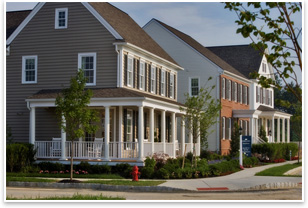
Developing “What Is Special About Place” Summary: One developer is finding that there is more to business than putting homes on lots. Rob Bowman, president of Lancaster (Pa.)-based Charter Homes and Neighborhoods, with his team, is helping redraft zoning and land ordinances in many Central Pennsylvania towns and cities to ensure that development considers “what is special about place.”
This is a formula that yields thoughtfully planned great spaces, Bowman says. “There is a strong sense of what came before in this area, and a strong tradition of history, culture, and interest in what happens with the land.” But, because of the longevity of the rules on the books, “no one really owns them anymore,” Bowman says. That gives his firm the opportunity to consider ways to achieve growth smartly while maintaining neighborhood qualities. Bowman’s efforts are well recognized. Charter Homes and Neighborhoods’ work to reduce sprawl and preserve farmland is the subject of several news articles, including a feature in the New York Times. He told the paper that he used to build two or three homes per acre for its single-family developments, but for the last decade has opted to build communities with higher housing density, with as much open space as possible. The new rules preserve valuable land assets—meadows, old growth, creeks, and even the rolling hills—that define the area, the developer says. This is important in an area that is attracting interest from city dwellers seeking the open spaces of Central Pennsylvania. Engaging decision makers It is important to take these priorities and translate them into venues appropriate for the retail and housing markets. New rules are then developed to “back into” planning processes that the decision makers, designers, and developers can work toward. Every jurisdiction is unique, Bowman says. He notes that it takes a lot more effort and often a significant amount of time—sometimes additional cost—to rethink the fundamental building blocks of town planning. “It makes it much more challenging and adds steps to the process.” But by being upfront in the beginning, they can get the local stakeholders on board and ultimately end up with a process that nets a better product. There, are of course, concerns about costs, but Bowman offers that there is always a way to achieve great thoughtful design and come up with creative solutions. For his firm, he says, his track record speaks to “promises made, promises kept.” Designing in three dimensions You have to be designing in three dimensions all the time The developer says his architects are key partners in the search for solutions that satisfy zoning rules and space preservation ideals. “You have to be designing in three dimensions all the time.” Bowman suggests to architects trying to achieve these same goals or those who are working in partnership with developers to “get good at articulating your perspective on great design.” He says communicating ideas and working with stakeholders require different skills than being a great designer. He advised architects to avoid using vocabulary that is over the head of stakeholders. “You have to be able to sit down in a room and talk to average people.” |
||
Copyright 2007 The American Institute of Architects. All rights reserved. Home Page |
||
home
news headlines
practice
business
design
recent related
› “Bigger Is Better” No Longer Ruling Home Design
› AIA Announces Three Recipients of 2006 AIA/HUD Housing and Design Awards
Visit the Charter Homes and Neighborhoods Web site.

